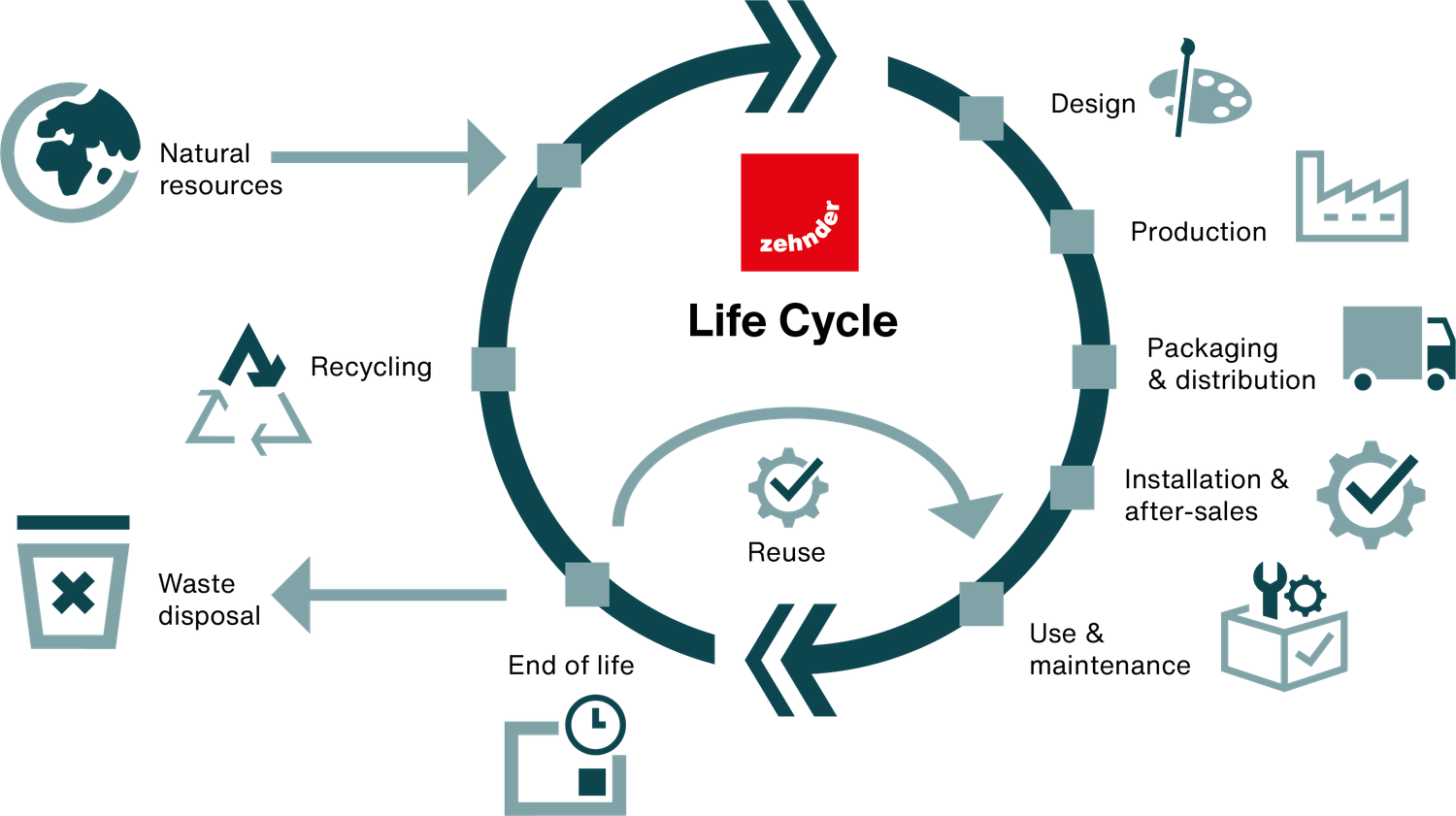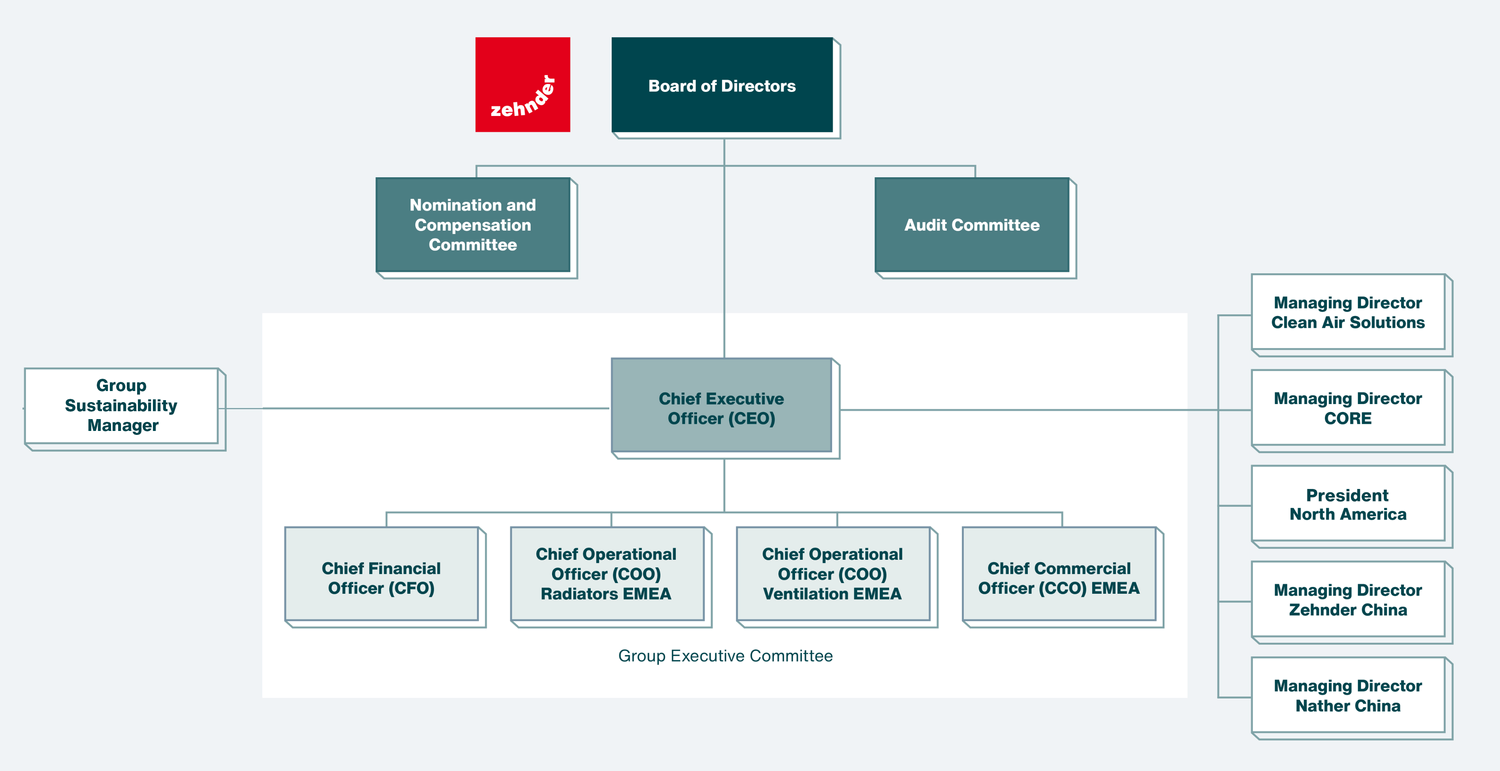Governance
Purpose and structure of organisation
Organisational purpose
Description of the Zehnder Group business model
Zehnder Group is a global leader in providing solutions for indoor climate management. Its primary purpose is to enhance comfort, energy efficiency, and health in residential, commercial, and industrial spaces through innovative products and systems. Energy efficiency means reducing energy consumption while maintaining optimal indoor conditions, lowering costs and environmental impact. Health and comfort are achieved by ensuring fresh air circulation, consistent temperatures, and improved air quality for well-being and productivity.
We design and manufacture our products in our own facilities across Europe, China, and North America. Our sales activities in over 70 countries are managed through local sales companies and representatives. Our value chain includes raw material acquisition, product development, procurement, production, distribution, customer support, and disposal. We maintain strong business relationships with suppliers, partners, and customers, guided by a commitment to sustainability and ethical standards. Since 2023, the company’s Articles of Association have emphasised sustainable value creation as a core aspect of its corporate purpose, influencing both its operations and external partnerships.
The Zehnder value chain

Organisational structure
Organisational chart Zehnder Group

The role of “President North America” has been assigned as of 1 January 2025.
Sustainability organisation of Zehnder Group
Zehnder Group’s governance framework ensures effective decision-making and a comprehensive oversight of sustainability impacts. This structure is designed to align the company’s sustainability objectives with its operational and strategic goals.
Several committees form the foundation of this governance framework:
- The Board of Directors, as the highest authority, is responsible for managing and overseeing the sustainability strategy and its impacts. Comprised of seven non-executive members, five of whom are considered independent in accordance with best practice corporate governance standards. This means that they are not employed as a member of the Group Executive Committee, or by any subsidiary of Zehnder Group and have no material relationship with any part of the organisation.1
- The Audit Committee comprises members from the Board of Directors and oversees effective management of sustainability and climate risks, integrating them into the overall risk management framework. It reviews significant risks and compliance on a regular basis and at least once a year.
- The Nomination and Compensation Committee comprises members of the Board of Directors and manages sustainability-related remuneration and incentives, ensuring that sustainability is factored into the compensation of senior executives.
- The Group Executive Committee comprises senior executives overseeing the company’s operational management. Representing key functions and geographical regions, they ensure effective decision-making and drive the implementation of the sustainability strategy.
- The Sustainability Steering Committee, chaired by the CEO, includes the Chairman of the Board of Directors, the Group Executive Committee, and senior management members. It develops and oversees the company’s sustainability strategy, ensuring alignment with corporate objectives and promoting cross-functional collaboration at the leadership level.
Stakeholder representation is embedded within the governance structure, with the Sustainability Steering Committee responsible for stakeholder engagement. Regular stakeholder analysis as part of materiality assessments ensures stakeholder expectations are integrated into decision-making. The representation of underrepresented social groups has not yet been assessed, as an internal definition still needs to be developed.
1Detailed external commitments of Board members are outlined in the Corporate Governance Report.
Delegation of responsibility
The Board of Directors delegates responsibility for managing economic, environmental, and social impacts to senior executives, ensuring clear accountability and regular sustainability reporting:
- The Group Executive Committee is tasked with developing and implementing the sustainability strategy and defining the corresponding sustainability objectives, ensuring alignment with overall business goals and strategic priorities.
- The Competence Centres, including Radiators and Ventilation, the Managing Directors of Clean Air Solutions, CORE, Zehnder China and Nather China, and the President North America implement sustainability measures within their domains, collecting KPIs from production sites and submitting regular reports.
- The Group Sustainability Manager, reporting directly to the CEO and supported by two team members, coordinates sustainability processes, develops strategies, and ensures their execution across the organisation. Responsibilities include overseeing sustainability data collection and reporting, culminating in an annual review of the company’s sustainability performance. This review, including the Sustainability Report and compliance updates aligned with frameworks such as GRI and TCFD, is then presented to the Board of Directors and the Group Executive Committee.
- The Sustainability Steering Committee serves as the central body for sustainability strategy development and decides on definitions of targets and the implementation of specific measures to achieve them.
- Other Group Functions that are not directly part of the Sustainability Steering Committee but represented by the CFO, like Legal and Compliance, Finance and Controlling, and Group Procurement, are heavily involved in implementing the sustainability strategy and driving measures to achieve the sustainability targets.
Reviewing and approving the information
The Board of Directors reviews and approves the reported information, including the organisation’s material topics. This process involves a structured multi-level review, starting with local data collection and validation by sustainability ambassadors, followed by oversight from Group Controlling and Group Sustainability, and final approval by the Group Executive Committee before submission to the Board.
Expanding the collective knowledge
Zehnder Group has implemented initiatives to strengthen the sustainability knowledge and expertise of its Board of Directors, ensuring the Board is fully equipped to integrate sustainability into the organisation’s overall strategy.
Sustainability expertise is a key criterion in recruiting new members; currently, five of the seven members bring insights from their involvement on other boards while four members have completed seminars and training programmes on sustainability-related topics. These programmes enhance their understanding of global sustainability trends, regulatory changes, and best practices.
Every two years, the Board of Directors conducts a self-assessment to evaluate its performance, including its approach to sustainability. This process helps to identify areas for improvement and ensures sustainability remains embedded in governance practices.
Prevention and mitigation of conflicts of interest
Zehnder Group has established clear procedures to prevent and manage conflicts of interest within its governance framework. These procedures are embedded in the Articles of Association and Organisational Regulations, outlining the responsibilities of Board members and senior executives, as well as in the Code of Conduct. Statutory rules limit the number of external engagements members of the Board of Directors can undertake, ensuring their duties remain aligned with the Group’s interests.
Board members and senior executives are expected to avoid any conflicts of interest with Zehnder Group, including agreements or benefits that could impair their independent judgement. In case of a potential conflict, individuals must notify the Chairman of the Board of Directors in writing. If the conflict involves the Chairman, the notification is directed to the Vice-Chairman. The Chairman (or Vice-Chairman) assesses the situation and informs the Board of Directors if needed, recommending actions. In urgent cases, immediate measures can be taken and later reported to the Board of Directors.
All conflict disclosures and actions are documented to ensure transparency. Zehnder Group discloses material conflicts of interest to stakeholders where necessary, including areas such as cross-board memberships, business dealings between the company and governing bodies, or related parties. These transactions are conducted at arm’s length to ensure fairness and transparency.
Communication of critical concerns
Critical concerns are routinely communicated to the Board of Directors, ensuring efficient and transparent handling of sustainability, risk, and compliance issues. The Audit Committee reviews significant risks, including compliance, legal, and sustainability issues, meeting regularly and receiving an annual compliance report on critical concerns. There is continuous communication between the Chairman of the Audit Committee and the Group General Counsel as well as the Head of Group Internal Audit, ensuring prompt escalation of critical legal or regulatory concerns to the highest governance levels.
Employees and stakeholders can raise concerns through internal reporting channels, such as compliance violations or operational risks, which are then escalated to senior management and communicated to the Board of Directors when deemed critical. The Board of Directors receives updates from the Sustainability Steering Committee on risks related to environmental, social, or economic impacts.
The number and nature of critical concerns raised during the reporting year are addressed within Compliance and fair business practices.